Notice
Please be aware that Hestercombe will be closed on Christmas Day and Boxing Day, but will be open daily throughout the rest of the Christmas holidays.
The next instalment from the Hestercombe Archives explores the fascinating early history of 'Haegsta’descumb', from 682 - 1391
Please be aware that Hestercombe will be closed on Christmas Day and Boxing Day, but will be open daily throughout the rest of the Christmas holidays.
As far as the valley of Helsdena (Hel . . . ‘s Valley). Then by a brook to the ford which is called Wealaford (Ford of the Welsh or Celts). And so along the course of that brook to the channel of the Tan (Tone). They (the 23 hides) have on the west the spring called Ealduuylle (Old Spring). After that another spring called Acuuille (Spring of the Oaktrees). From that spring to the place called Haegsta’descumb (Hegstald’s Combe [Hestercombe])
~ [Saxon Charter of 682 -- G. B. Grundy, The Saxon Charters and Field Names of Somerset (Taunton: Somerset Archaeological and Natural History Society, 1935), p. 51.]
Roman rule in Britain formally ended in AD 410. Three north European tribes, the Angles (southern Danish), Saxons (German-Dutch) and Jutes (northern Danish) subsequently invaded and colonised much of southern England, with the ‘West Saxons’ under Cerdic and his son, Cynric, founding Wessex (the kingdom of the West Saxons) in about AD 495 after landing in Hampshire. The nucleus of the new kingdom eventually comprised what became known by the late 10th century as the southern English counties of Dorset, Somerset, Wiltshire and Hampshire.
In about 682 the eleventh of the West Saxon kings, Centwine (reigned 676-685), brother of Cenwalh who had conquered Somerset for the West Saxons just 24 years earlier, granted the abbot of Glastonbury, Hamegils (also Haemgils), 23 hides of land at Cantucuudu, or Quantock Wood in West Monkton. Centwine, who is remembered as a strong king -- to prolong the expansion of Wessex to the south-west (Devon) he ‘drove the Britons as far as the sea’ – was an extremely generous benefactor of the recently founded Abbey. His grant included the whole of West Monkton as well as the west part of Creech St. Michael, north of the River Tone. Significantly, the survey attached to the award mentioned for the first time the property we know of today as Hestercombe, identifying it as Hegstald’s Combe.
...Then to Bachelor’s Combe (Hegsteldescumb)...
~ [Saxon Charter of 682 -- G. B. Grundy, The Saxon Charters and Field Names of Somerset (Taunton: Somerset Archaeological and Natural History Society, 1935), p. 21.]
There would be no further mention of the future home of the De Moncels, De Fluris, De Meriets, De la Warres, Bampfyldes or Portmans until the 22nd of April 854. On this date Aethelwulf (also Ethelwulf) (Fig. 1), a West Saxon monarch revered for his protracted, and sometimes successful, campaigns against the Viking invaders – his most famous victory at Ockley, Surrey (851) brought about "the greatest slaughter of heathen host ever made" -- increased the lands of the Bishopric of Winchester in the Taunton locality with the largest grant recorded in all known Saxon land charters.
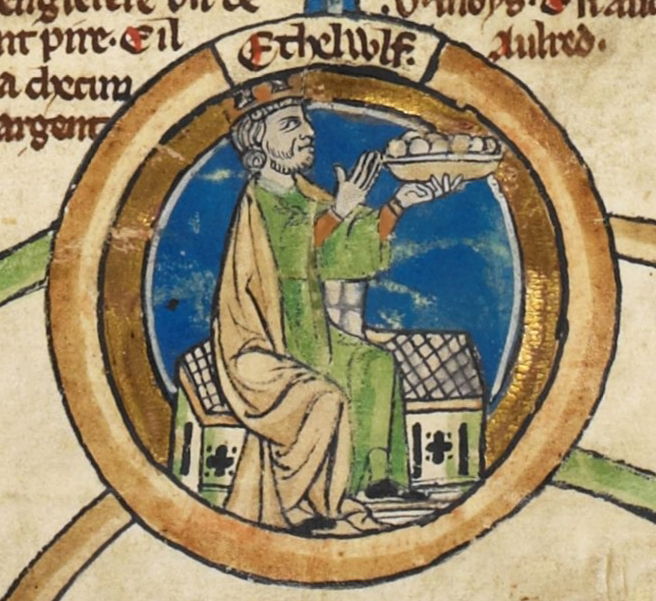
The great Taunton Charter conferred upon Ealhstan, bishop of Winchester -- and principal adviser to Aethelwulf in financial and military matters -- 133 hides of land (about 43,000 acres [17,400 ha.]) enclosed by a boundary some 80 miles (129 km.) in circumference. The grant included Otterford, Corfe, Orchard Portman, Stoke St. Mary, Duddlestone in Pitminster, Taunton, Wilton, Trull, Angersleigh, Bishop’s Hull, Bradford, Nynehead, Oake, Heathfield, Halse, Ash Priors, Combe Flory, Tolland, Lydeard St. Lawrence, West Bagborough, Bishop’s Lydeard, Cothelstone, Norton Fitzwarren, Staplegrove, Cheddon Fitzpaine, West Monkton, Ruishton, the west section of Creech St. Michael and possibly Crowcombe.
Hestercombe was named in the Taunton Charter as 'Hegsteldescumb' or 'the valley of the haegsteald', haegsteald being an old English term for a warrier bachelor. According to a leading authority on the subject of place names, E. Ekwall, formerly Professor of English at Lund University, Sweden (1909-1942), Hestercombe may once have been the domain of the younger son of a Saxon chief who, by virtue of having an elder brother, had no claims on his father’s village and had to take up a land holding for himself elsewhere.
During the rule of Edward the Confessor (1042-1066), Hestercombe was included in the land holdings of the abbey of Glastonbury (Figs. 2 & 3), now one of the richest monasteries in England. It was being referred to as 'Hasecumbe' when the Domesday Survey was drawn up in 1086 to provide records and a census of life in England for the newly established Norman administration.
William the Conqueror (reigned 1066-1087) had by this time transferred the ownership of the ancient Somerset manor to his trusted adviser, the militaristic, but also ecclesiastically active, Bishop of Coutances, Geoffrey de Montbray (d.1093) (Figs. 4 & 5).
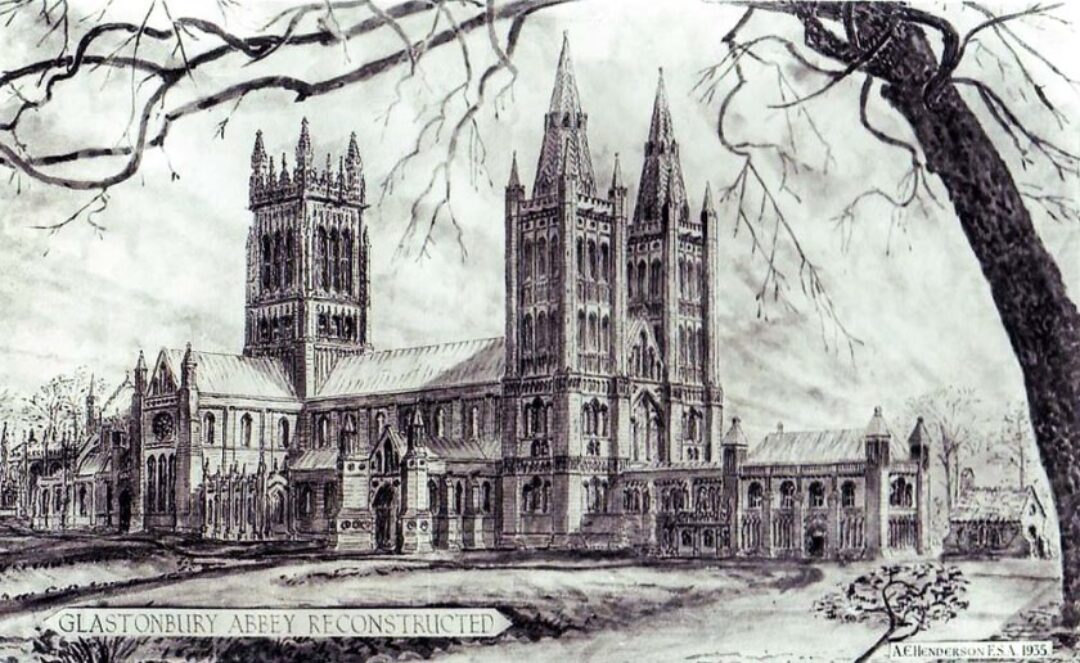
The Bishop, who had fought with William at the Battle of Hastings and played a key role in the unification of post-conquest England was now one of its greatest landholders, having received for his services some 280 manors scattered over 12 counties, but with the majority in just two: Gloucestershire and Somerset. Hestercombe was summarily described in the Domesday Survey (Fig. 6) as a working manor of 500 to 600 acres: 'The same Bishop holds Hasecumbe, and William of him. Four Thanes held it in the time of King Edward, and gelded for two hides (240 acres [97 hectares]) and three virgates (90 acres [36 hectares]) of land. The arable is three carucates (360 acres [145 acres]). In demesne are two carucates (240 acres [97 hectares]), with one servant, and four villanes (also villeins), and eight cottagers, with two ploughs. There are thirty-one acres of meadow, and ten acres of coppice wood. It was worth forty shillings, now fifty shillings.'
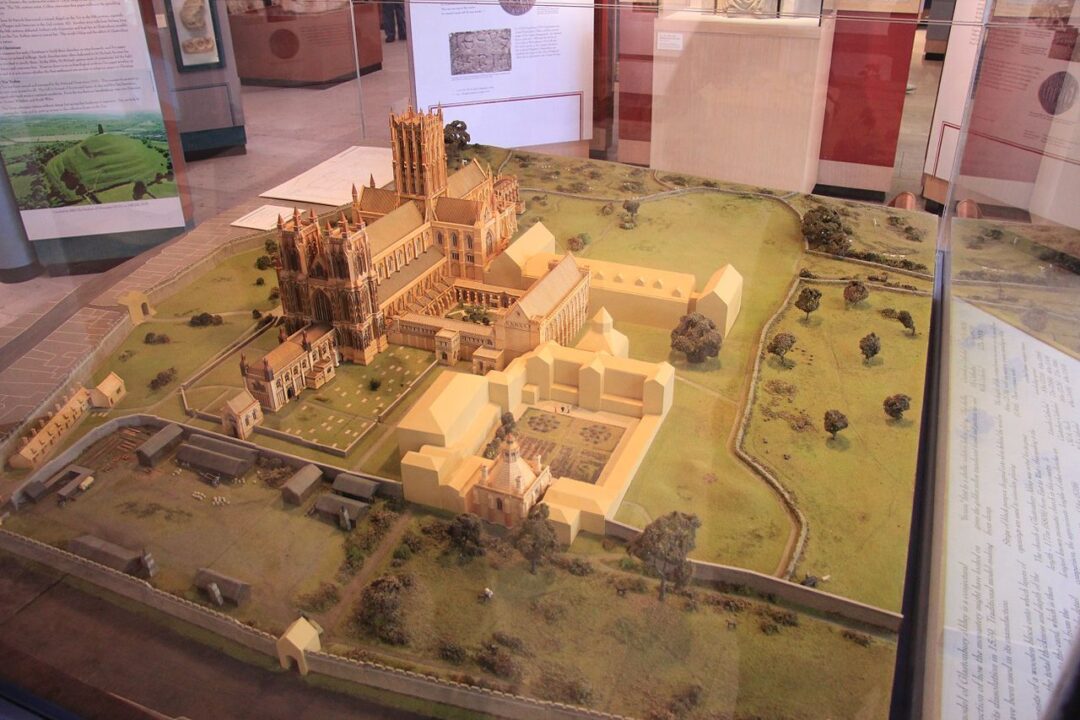
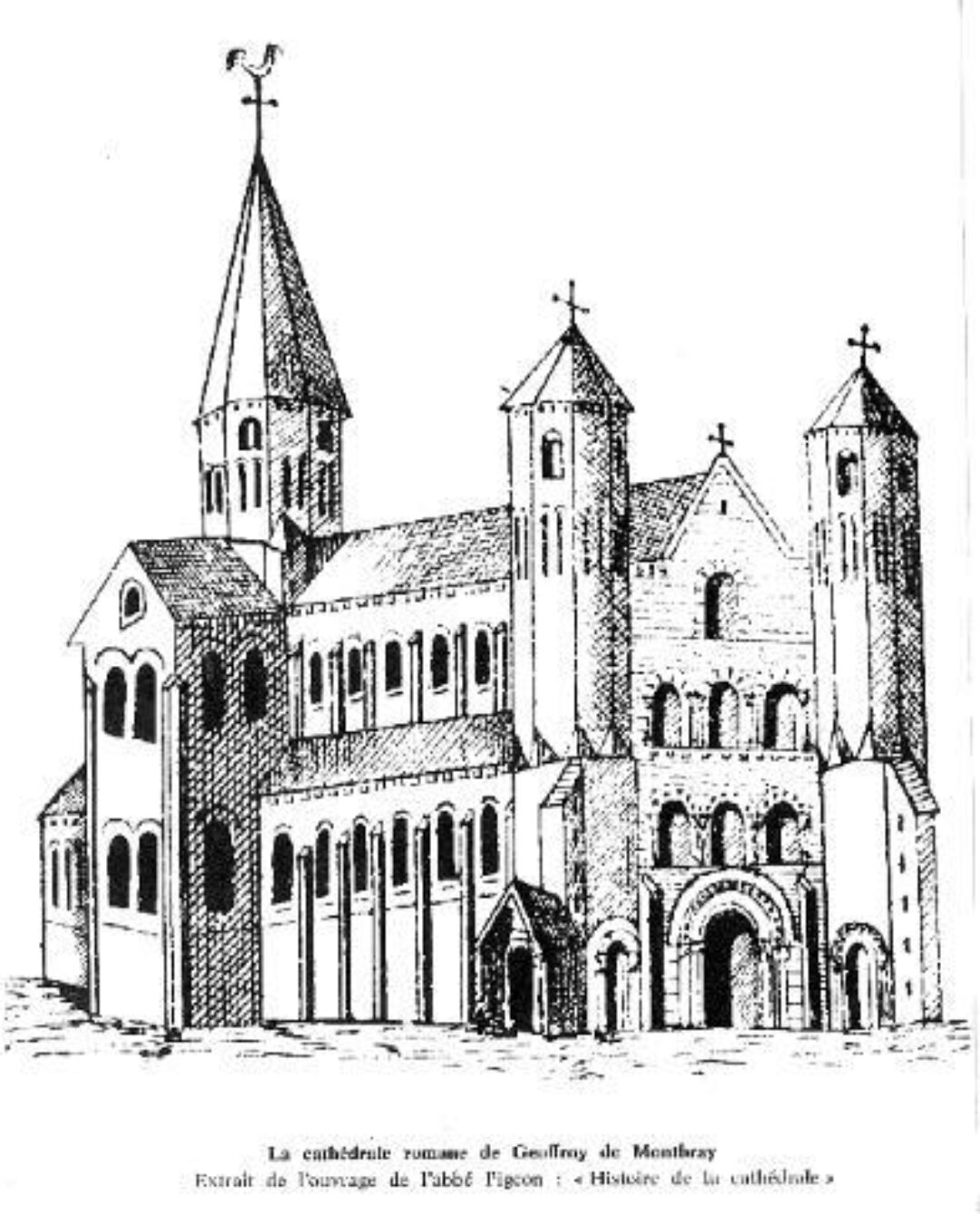

King Edward the Confessor, seventh son of the warrior king Aethelred II, reigned 1042-1066 and was succeeded by Harold II (d.1066), second son of Godwine, earl of Wessex (d.1053), the most powerful nobleman in England. King Harold narrowly lost the English throne to William the Conqueror during the day long battle of Hastings on the 14th of October 1066.
In Anglo-Saxon England a thane (also thegn) was a nobleman, a member of the military elite (similar to a knight in medieval times) whose precise social standing was, broadly speaking, defined according to a threefold ranking: earls, then king’s thanes and finally, median thanes. The Hestercombe thanes were probably of the median – middling – persuasion, prosperous landholders of local importance who held their land through intermediary lords in return for military service. The more powerful royal thanes held their land directly of the king and could be members of the royal household with a position in government. A demesne, from dominicus ‘belonging to the lord’, was that portion of the manor reserved exclusively for the personal use/benefit of the lord.
Following the Conquest, a villane was any unfree tenant who was legally bound to his tenement which he held subject to fines (fees paid for leases) and agricultural work on the lord’s demesne lands (usually 2-3 days per week). The geld was an Anglo-Saxon land tax continued by the Normans and assessed on the number of hides owned. The hide was originally meant to denote the amount of land that could be ploughed yearly by a team of eight-oxen. It could vary widely prior to the Conquest, depending on the quality of the land. For example, G. Grundy states that the number of acres to the hide in the great Taunton Charter of AD 854 was 323 acres ‘which is something like the acreage per hide indicated by charters of other counties referring to regions which were, like the greater part of this one, heavily wooded in former days’. In post conquest England the hide appears to have evolved into a land unit of about 120 acres. Each hide (also known as a caracute) was composed of four virgates.
The Bishop of Coutance's under-tenant at Hestercombe at the time of the Domesday Survey was William de Moncels (also Moncelles), Lord of Maers and Monceaux in lower Normandy. De Moncels also tenanted some of the Bishop’s other land holdings in Devon and Somerset, one example being Dowlish Wake near Ilminster. At Hestercombe William maintained ‘10 beasts (cattle), twenty swine and one hundred and forty-three sheep’.
In the early 12th century, William de Moncels sold Hestercombe to another prominent Norman family. Hugh de Fluri (also Flory, Fleury, Flury), who had recently succeeded Baldwin de Cumbe as lord of the nearby manor of Combe Florey, was in turn succeeded by his son, Ranulf de Fluri. (Until about 1110, de Cumbe, who held several other manors in the vicinity, including Stogumber and Combe Sydenham, possessed Combe Florey of the Bishop of Winchester in return for three knights’ fees.)
In addition to Hestercombe and Combe Florey, the Fluri’s were also in control of the West Somerset manors of Leigh Flory or Pyleigh in the parish of Lydeard St. Lawrence, Withiel Flory in the parish of Brompton Regis, and Nynehead Flory in the parish of Nynehead. It was between the last two estates that the family alternated its principal residence during the medieval period. The devout Hugh de Fluri eventually gave 20 acres [8 ha] of his Hestercombe land holdings to the Priory of St Peter and St Paul, Taunton, a powerful Augustinian monastery founded about 1115 by William Gyffarde (Giffard), Bishop of Winchester and Chancellor of England, but later dissolved (1539) by Henry VIII. The priory (Fig. 7), which was located within sight of Tobrigge Mill with the well-treed Hestercombe estate visible beyond, lay alongside the River Tone just beyond what was then the eastern boundary of Taunton.
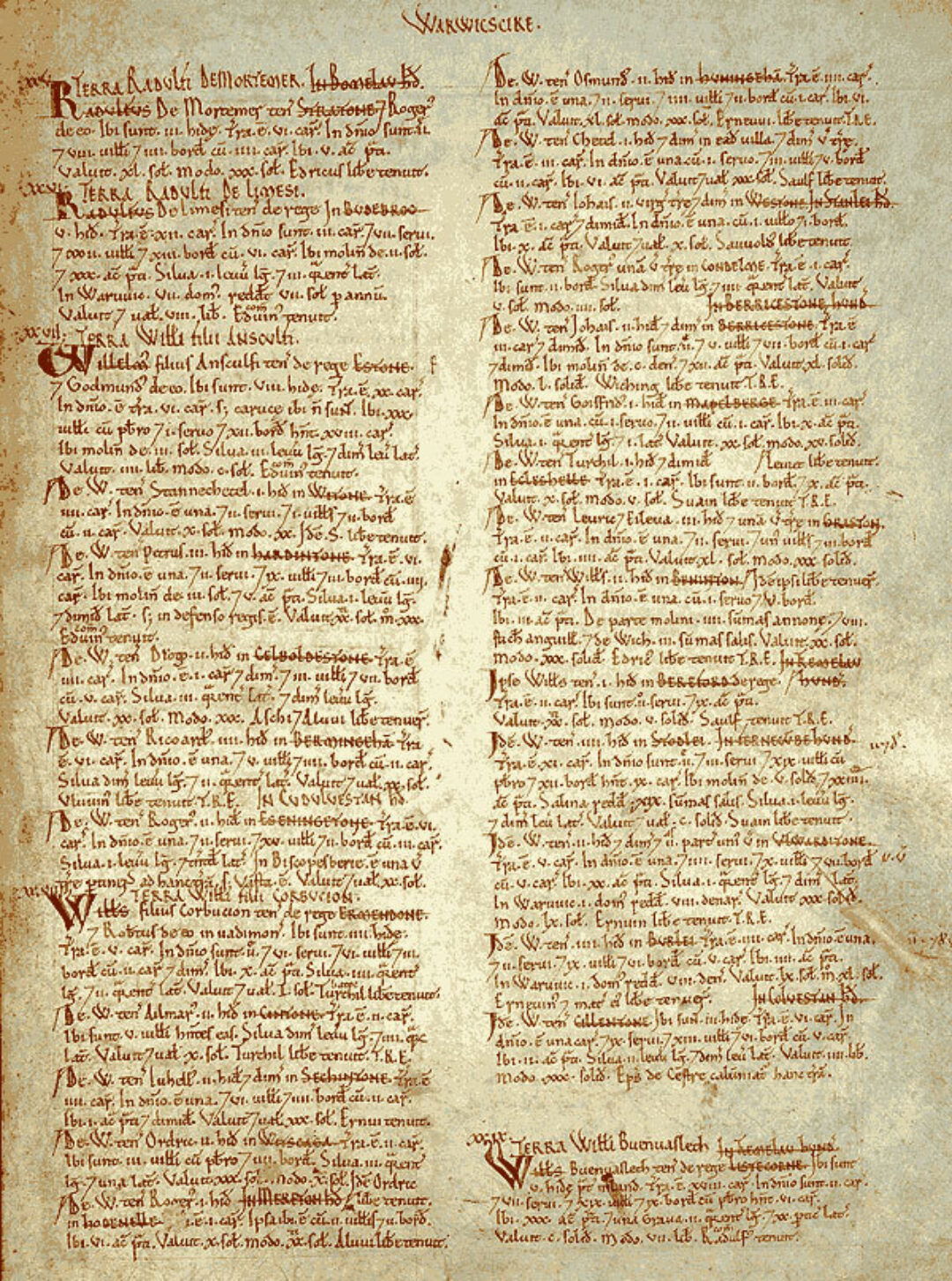

The Fluri’s remained in possession of Hestercombe well into the reign of Edward I (1272-1307). Then, in the late 13th century, the estate was conveyed to a branch of the De Meriet family, an eminent Anglo-Danish house that claimed descent from Harding (also Heardinc) de Meriet, son of Eadnoth the Staller, a royal justice and steward under Edward the Confessor who in the early 1060s was a major landowner in England with estates in Somerset, Devon, Wiltshire, Dorset, Gloucestershire, and Berkshire. Following the Conquest, Eadnoth managed to retain his properties by transferring his allegiance to William I, but was killed in 1068 at Bleadon whilst repelling an unsuccessful attempt by the sons of the late king Harold to capture Bristol.
Harding de Meriet (d.1140) served as a royal justice under William II (reigned 1087-1100) and is remembered as a man of some resolve. William of Malmesbury, the distinguished 12th century historian wrote that ‘he appears to have been thriven by forensic rather than martial genius’; B. W. Greenfield thought him ‘the greatest of the Somerset Anglo Thanes’. Despite being denied succession to his ancestral estates by William the Conqueror – after Eadnoth’s death in 1068 his properties were granted to the influential Norman noble, Hugh d’Avranches, 1st earl of Chester (d. 1101) -- Harding became a significant landholder in Somerset, amassing no fewer than six manors in the county by 1086. A portion of the divided manor of Meriot (Merriott) eventually passed to Harding’s eldest son, Nicholas FitzHarding (d. c.1171). (At the time of the Conquest Meriet consisted of two separate estates; one of seven hides [840 acres (340 ha.)] that the Conqueror later granted to his half-brother, Robert, Count of Mortain, who administered a total of 86 manors from his stronghold at Montacute; and a second smaller estate of five hides [600 acres (242 ha.)] that had been the property of King Harold’s father, Godwine, earl of Wessex, but which had passed by 1086 to Harding de Meriet.) Succeeding generations consolidated the two holdings and set about acquiring additional lands elsewhere in the county such that by 1341 the De Meriets were also in possession of the manors of Combe Florey, Hestercombe, and Bradford (nr Wellington) – but also held some 1,500 acres of tenanted land at Bickley (nr Chipley), Wyke Champflower (nr Bruton), Pyleigh, Withycombe Weeke and Eastcote (nr Minehead), Elworthy and Plash (nr Frome), Brompton-Ralph, Capland (nr Hatch Beauchamp), Long Ashton (nr Bristol), and Cerney, the last in the county of Gloucestershire.
Combe Florey and Hestercombe both appear to have entered the fold in the late thirteenth century. Sir Simon de Meriet (d. c.1295) and his wife, Lucy (d. c.1324), daughter of Sir William Malet of Enmore, were occupants of the former as early as 1262 and by 1293 their son, Sir John de Meriet ‘Le Neveu’ (to distinguish him from his cousin, Sir John de Meriet, Kt., of Meriet) had completed the purchase of 13 acres of meadow and arable land from ‘John de Hestercombe’ for the handsome sum of one sparrow-hawk. This Sir John de Meriet was confirmed as living at Hestercombe by June of 1306 along with his new wife, Elizabeth Paynel (d. 1334). (On this date a final accord was concluded at Westminster conveying the manors of Hestercombe and Leigh Flory to trustees to hold for their joint use.)
The knightly Sir John, who held Hestercombe by knight's service of the Bishop of Winchester as of his manor of Taunton, celebrated his new situation – he was, after all, now “of Hestercombe” – by building a private chapel for his household and obtaining a licence for its use from John de Drokensford, Bishop of Bath and Wells in July 1316 (Fig. 8). The two men had not always been on easy terms. Only two years earlier in March 1314 De Drokensford had overturned a sentence of excommunication passed after Sir John de Meriet had disregarded Pope Clement V’s dictates and buried, separately, the body and heart of his first wife, Mary de Mohun, daughter of William de Mohun of Ottery Mohun and Stoke Fleming, Devon. To return to his worship’s good graces, De Meriet complied with an order from Berengar, Bishop of Tusculum, to rebury his wife’s heart with her body in her final resting place, the Church of St Peter & St Paul, Combe Florey. (During the 12th and 13th centuries double-internment -- one for the heart and another for the body -- was fashionable amongst the wealthy in England who considered it a status symbol and a means of obtaining added prayers for the deceased.)

Previous to these events, Sir John had been absent from his estate for extended periods of time in order to perform military service for his king, Edward II (reigned 1307-1327) (Fig. 9). Summoned by royal writs during the First War of Scottish Independence (1296-1328), he had fought against Scottish forces led by Robert the Bruce (Fig. 10) on at least three separate occasions in 1301, 1309 and 1314, the last date coinciding with a decisive Scottish rout of the largest ever English army to invade Scotland at Bannockburn near Stirling. (Sir John returned home safely, despite the loss of thousands of infantry, 100 knights and one earl.) Subsequently, at York, on the 9th of July 1319 De Meriet was rewarded for his loyalty with a charter of free warren. The prestigious royal grant applied to all of Sir John’s demesne lands at Hestercombe, Leigh Florey (Pyleigh), Combe Florey, East Copeland, and Long Ashton, prohibiting hunting there unless first licensed by Sir John de Meriet or his heirs forever. The penalty for ignoring the edict was ten pounds, a considerable sum for the time.
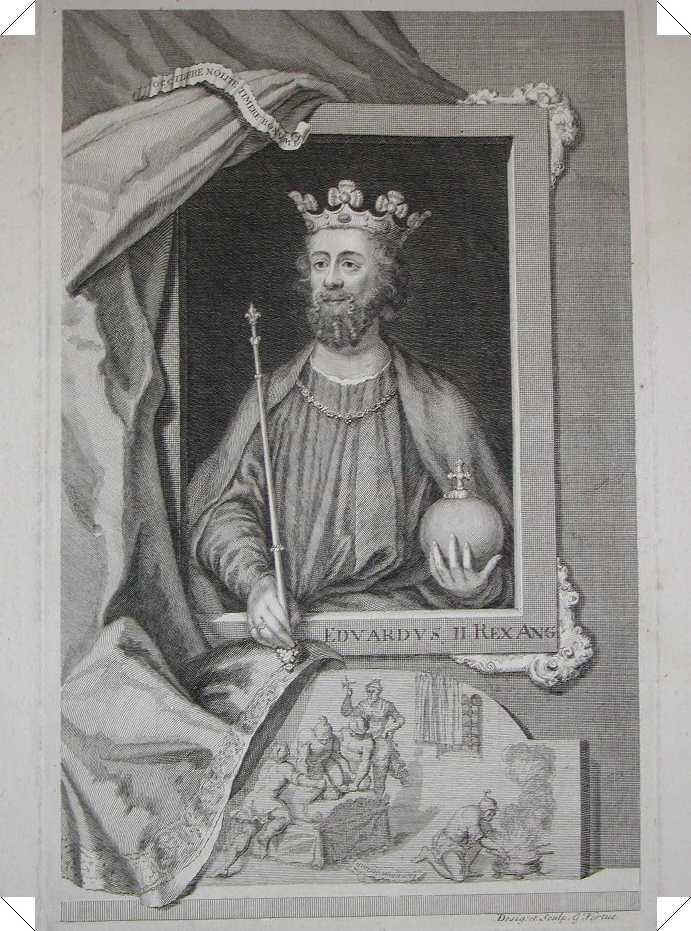
Sir John de Meriet died in 1327 and, like his parents and two wives, was interred in the Church of St Peter & St Paul, Combe Florey, confirming a strong attachment to the manor. Carved from Dundry stone, Sir John’s effigy (Fig. 11) still lies inside the Church at the east end of the north aisle. Legs crossed and resting on a lion, it is adorned with a coat of chain mail, protective neck shields (ailettes), an arm shield, military belt and sword. Nearby are the memorials to Sir John’s two wives: Mary, daughter of William de Mohun of Ottery Mohun near Luppitt, Devon; and Elizabeth, widow of Philip Paynel of Combe Kaynes and Rampisham, Dorset.
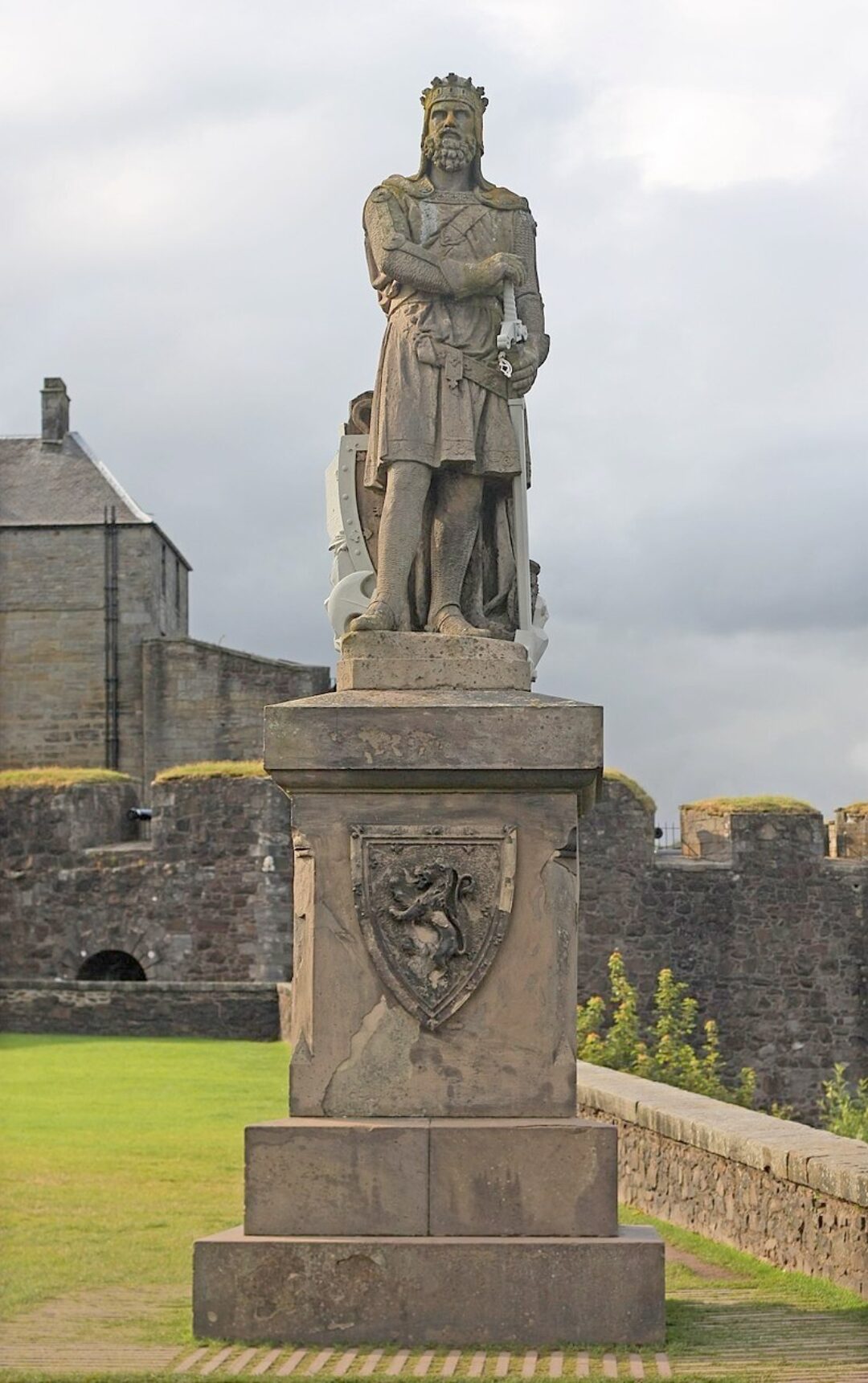
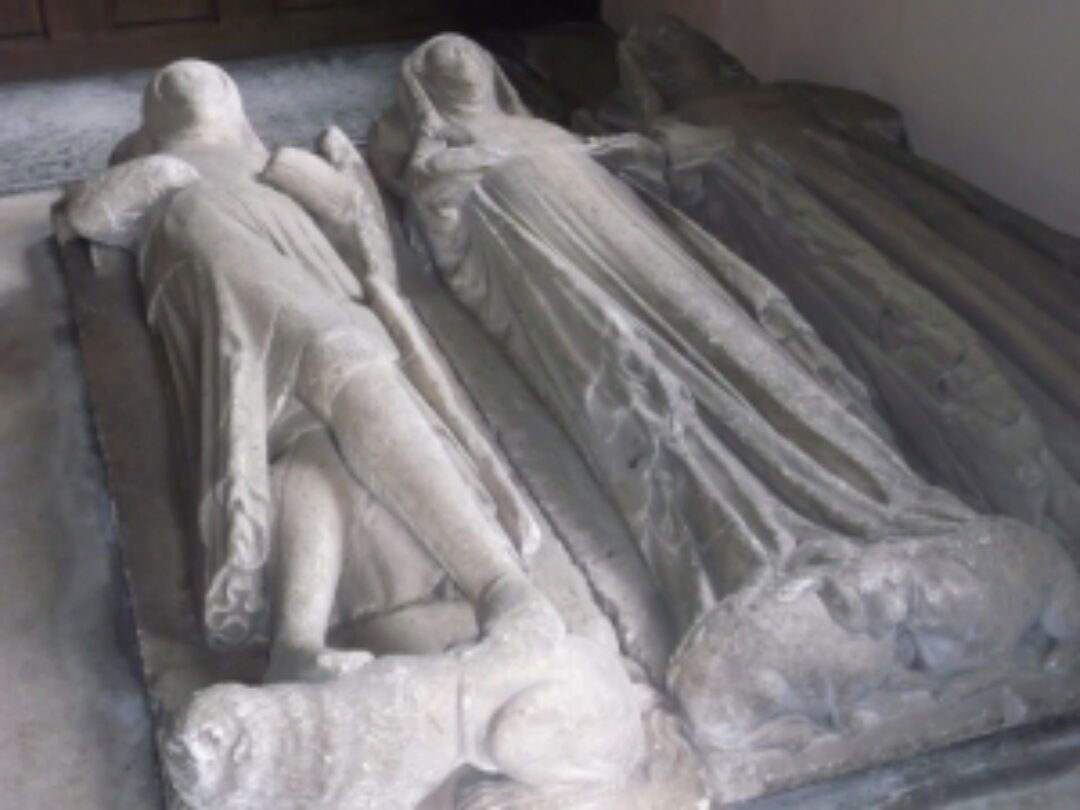
There are two leading schools of thought as to what happened next. In his lengthy treatise 'Hestercombe', published 1872 in Proceedings of the Somersetshire Archaeological and Natural History Society (vol 18), the noted Somerset antiquarian, Rev. Thomas Hugo maintained that Hestercombe remained De Meriet property for a further 64 years until the last of the family to own the property, another Sir John de Meriet, died without male issue towards the end of the 14th century.
Hugo goes on to state that, in 1391, the same Sir John de Meriet’s only daughter and heir, Elizabeth, married John la Warre, son of Matthew la Warre (d.1354) and Felicia Denbaud, daughter of Philip Denbaud of Hinton St. George thereby bringing Hestercombe into the Warre family.
Having amassed estates in Devon, Kent, Sussex, Gloucestershire, and Somerset, the Warres (Fig. 12) were certainly well established by this time, having been among ‘the chief Knights and gentlemen that came into England with Wm the Conqueror’. John la Warre’s forefathers originated from a collateral branch of the Barons la Warre of Gloucestershire. The family’s principal seat in that county was established in 1207 when another John la Warre (d.1213) was granted the manor of Wickwar (nr Chipping Sodbury) by King John (reigned 1199-1216) in return for half a knight’s fee.
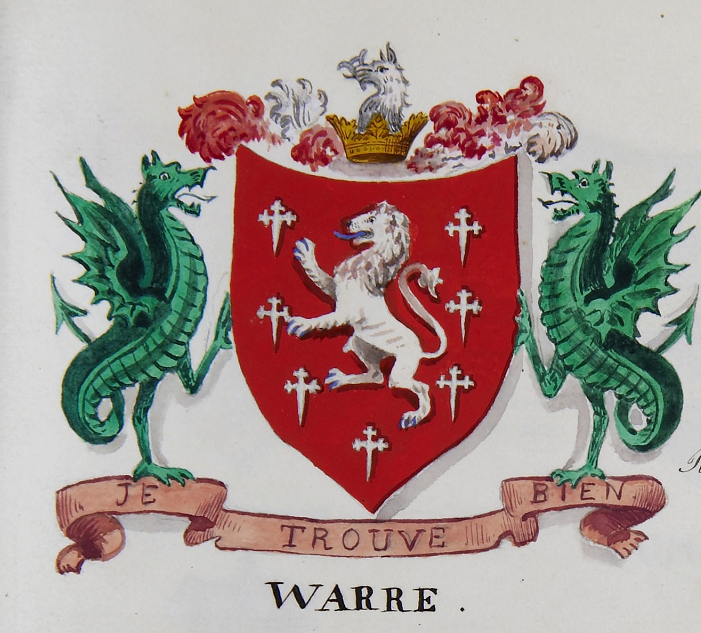
He [the late Rev. T. Hugo] merely copies Collinson’s account, which was prepared by the Rev. George Harbin and founded on the Visitation of Somerset in 1623. The Warre pedigree as given in that Visitation, contains many inaccuracies besides the erroneous assertion that a John Warre married the daughter and heiress of a John Meriet of Hestercombe.
~ (B. W. Greenfield, 'Meriet of Meriet and of Hestercombe', Somersetshire Archaeological and Natural History Society's Proceedings, vol 28 [1882], p. 99.)
Ten years after Revd. Thomas Hugo’s essay was published, a retired barrister, B. W. Greenfield, published a more exacting account of how the manor of Hestercombe devolved to the Warre family in 'Meriet of Meriet and of Hestercombe', Proceedings of the Somersetshire Archaeological and Natural History Society (vol 28). After an in depth examination of the De Meriet family’s lineage, Greenfield concluded that Sir John de Meriet’s son, Sir Simon de Meriet (d. 1372) was the last of his name to live at Hestercombe and that in the absence of a direct male heir, the manor passed to Sir Simon’s kinsman, Sir John de Meriet (1346-91) of Meriet. In 1375 this Sir John de Meriet sold the reversion of the manors of Combe Florey, Hestercombe, Bradford, Widecombe and several others to Baron of the Exchequer Sir Henry Percehay (d. 1380), with Sir Simon de Meriet’s wife, Margery, retaining them until her death between 1390 and 1393 (Sir Simon settled a life estate upon Margery of several of his manors and lands, including Hestercombe, in February 1347).
Sir William de Percehay, only son and heir of Sir Henry Percehay, died without issued in 1390 and the manor of Hestercombe passed by inheritance to Richard Warre. B. W. Greenfield does not elaborate on the background of this member of the Warre family, but he was almost certainly referring to Richard Warre (1347-?1403), son of John la Warre, who had married Joanna, daughter & heir of John Attwood whose wife, Gonalda was sister and coheir of Sir William Percehay. Greenfield also noted that Elizabeth, only daughter and heir of Sir John de Meriet of Meriet, actually married Urry Seymour around 1391, not John la Warre, as indicated by the Revd. Thomas Hugo.
This blog post was written by Kim Legate, Senior Archivist at Hestercombe Gardens Trust. Read more Archives blog posts.
Described as “one of the top twenty gardens to visit in the country”, Hestercombe is always beautiful throughout the year. Join today and enjoy great value: unlimited access to Hestercombe with prices from £4.21 per month.
Give a Gift of Membership to friends and family and they too can enjoy all the benefits of membership.
